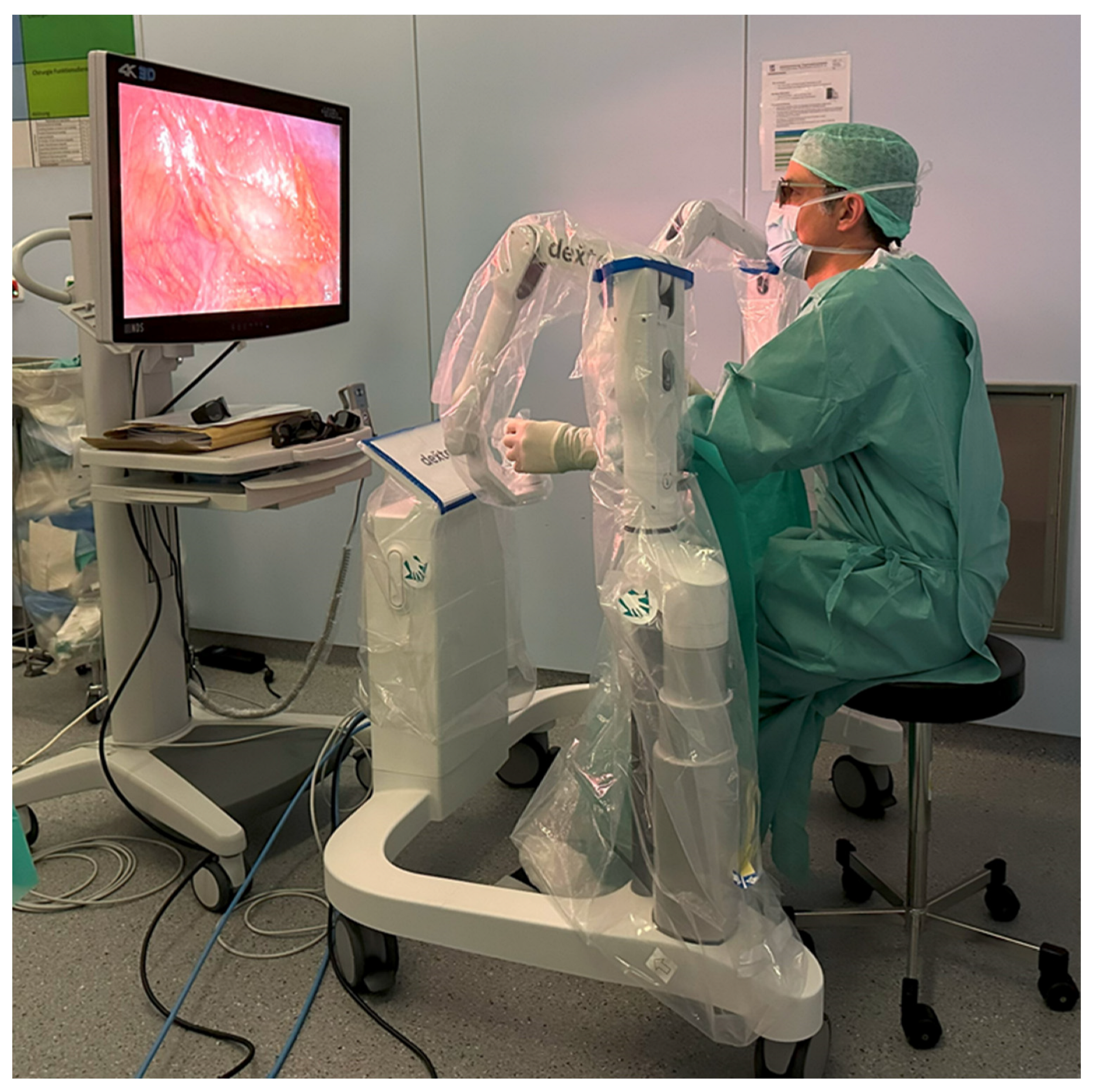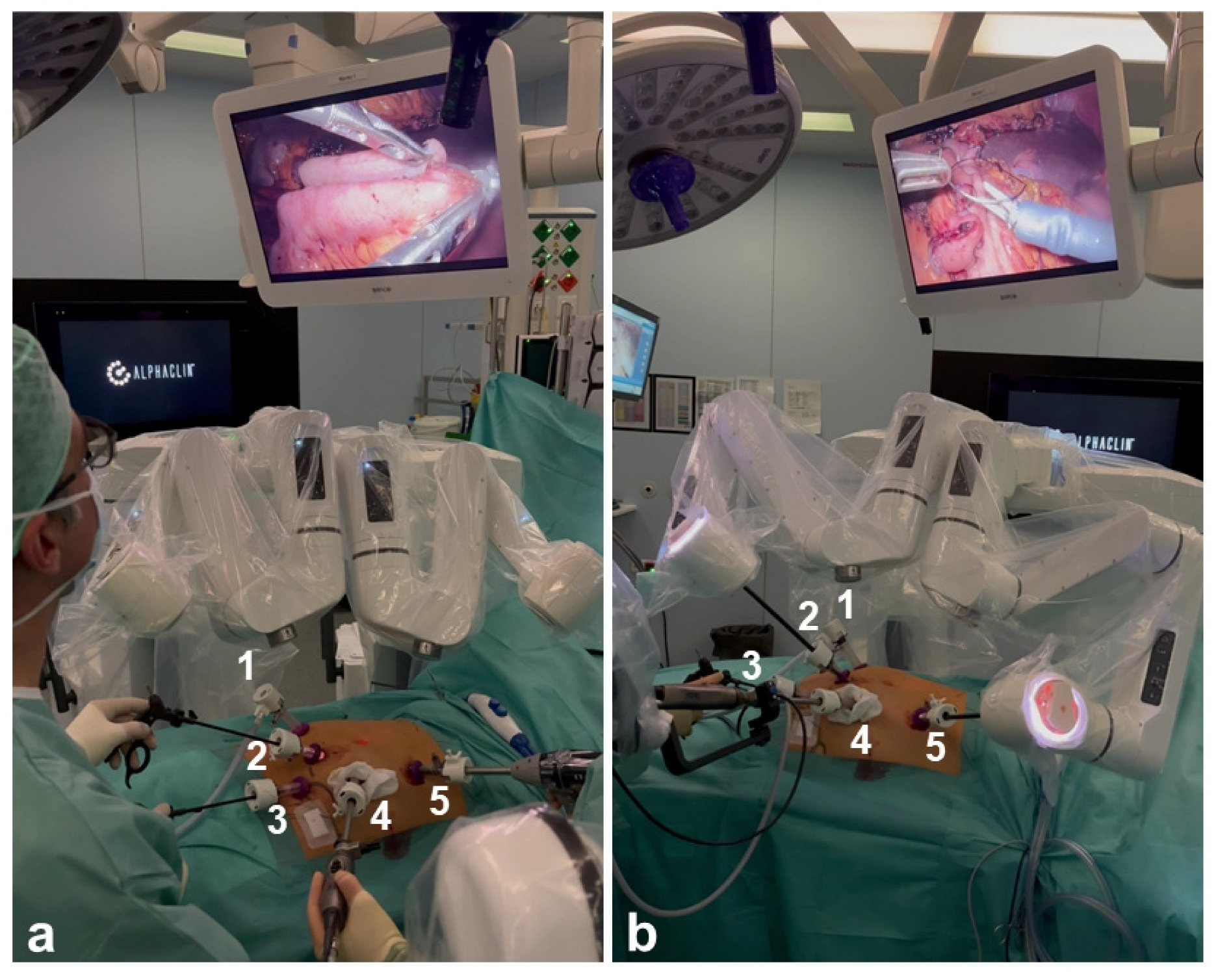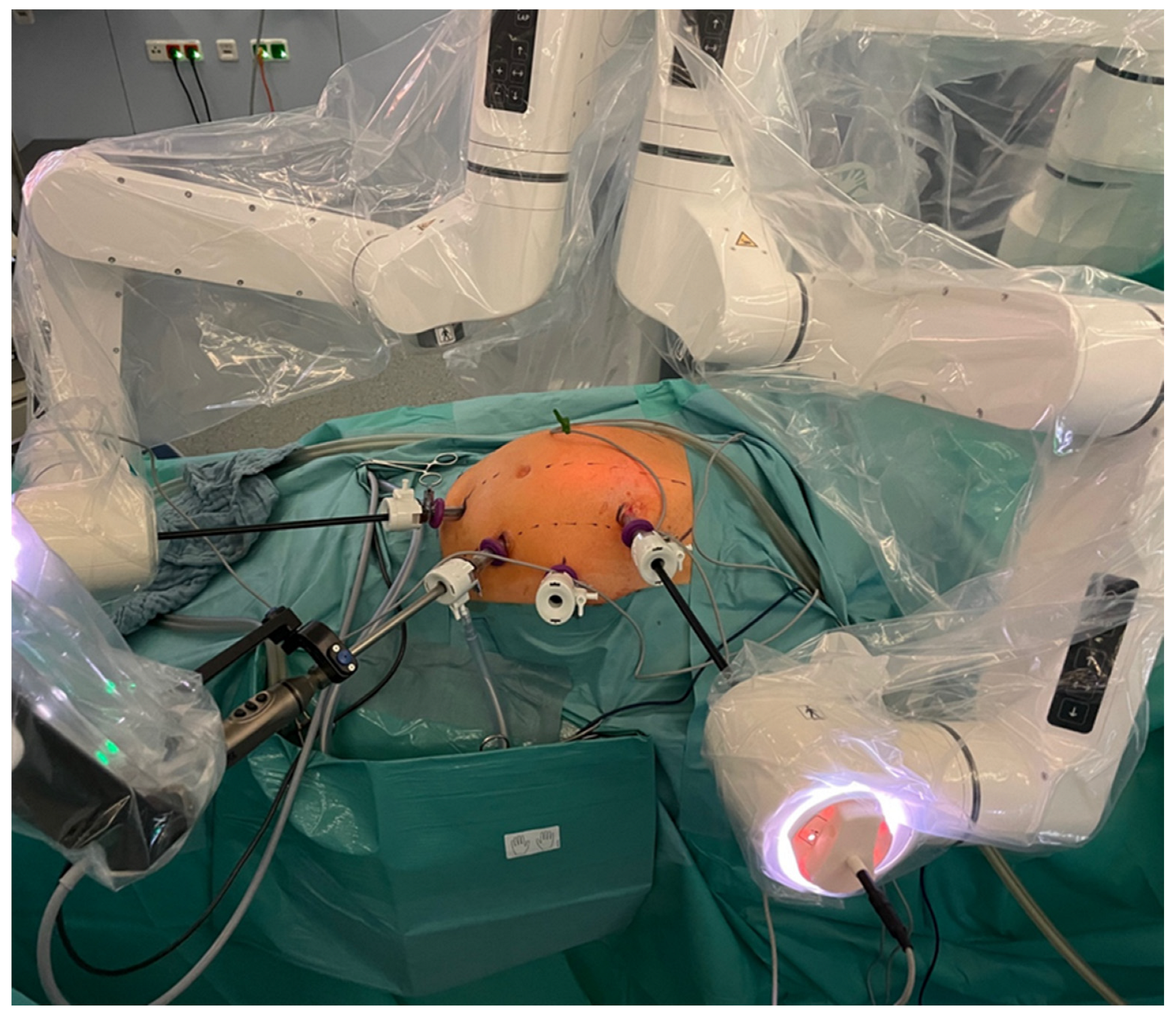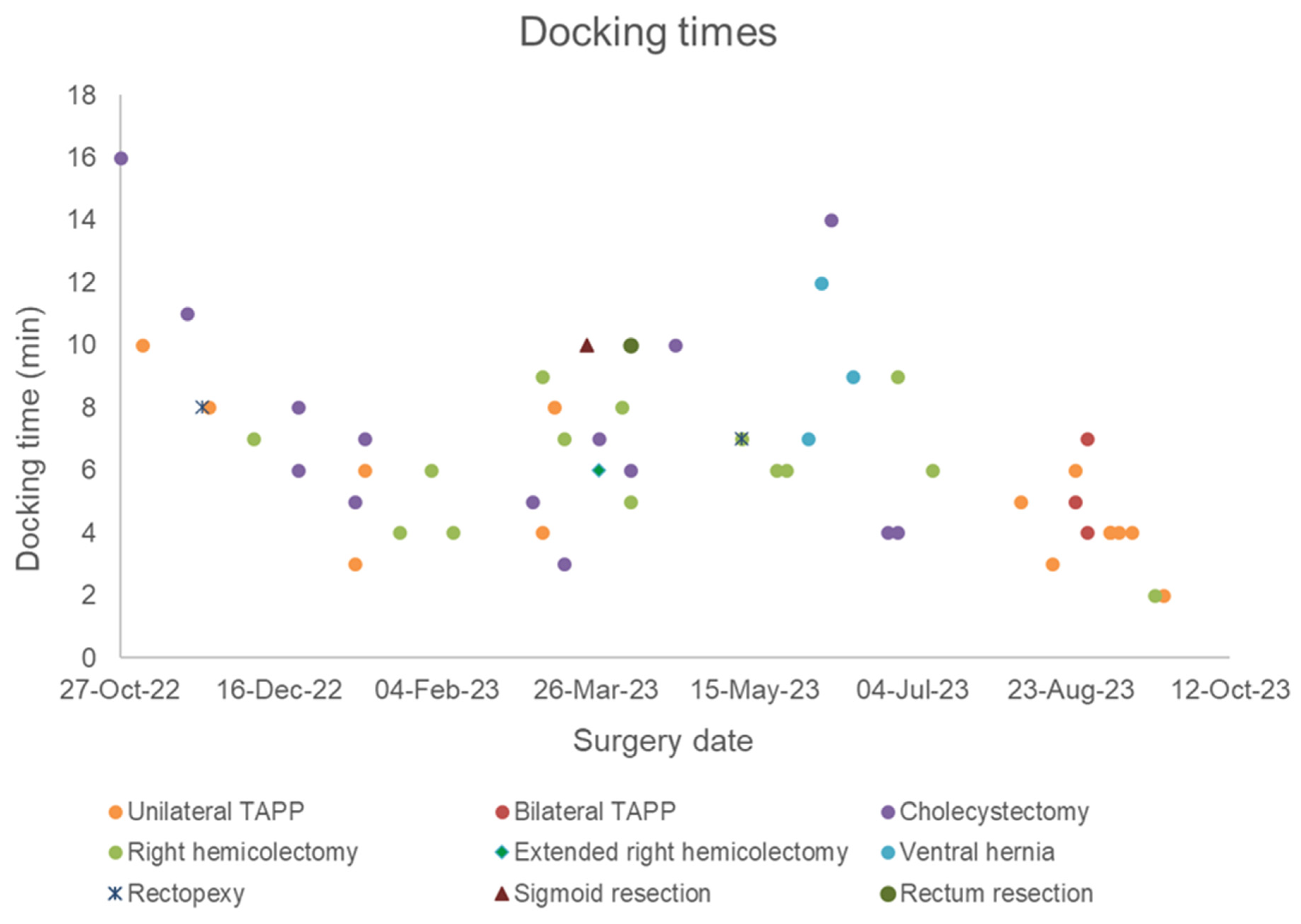The Combination of Laparoscopic and Robotic Surgery: First Experience with the Dexter Robotic System™ in Visceral Surgery
Abstract
1. Introduction
2. Methods
2.1. The Dexter System
2.2. Surgical Team
2.3. Patients
2.4. Data
3. Results
4. Discussion
5. Conclusions
6. Declaration
Author Contributions
Funding
Institutional Review Board Statement
Informed Consent Statement
Data Availability Statement
Conflicts of Interest
References
- Spaner, S.J.; Warnock, G.L. A Brief History of Endoscopy, Laparoscopy, and Laparoscopic Surgery. J. Laparoendosc. Adv. Surg. Tech. A 1997, 7, 369–373. [Google Scholar] [CrossRef] [PubMed]
- Lanfranco, A.R.; Castellanos, A.E.; Desai, J.P.; Meyers, W.C. Robotic Surgery. Ann. Surg. 2004, 239, 14–21. [Google Scholar] [CrossRef] [PubMed]
- Niklas, C.; Saar, M.; Berg, B.; Steiner, K.; Janssen, M.; Siemer, S.; Stöckle, M.; Ohlmann, C.-H. da Vinci and Open Radical Prostatectomy: Comparison of Clinical Outcomes and Analysis of Insurance Costs. Urol. Int. 2016, 96, 287–294. [Google Scholar] [CrossRef] [PubMed]
- Lee, M.R.; Lee, G.I. Does a robotic surgery approach offer optimal ergonomics to gynecologic surgeons? A comprehensive ergonomics survey study in gynecologic robotic surgery. J. Gynecol. Oncol. 2017, 28, e70. [Google Scholar] [CrossRef] [PubMed]
- Brunner, M.; ElGendy, A.; Denz, A.; Weber, G.; Grützmann, R.; Krautz, C. Roboterassistierte viszeralchirurgische Eingriffe in Deutschland. Die Chir. 2023, 94, 940–947. [Google Scholar] [CrossRef] [PubMed]
- Stucky, C.-C.H.; Cromwell, K.D.; Voss, R.K.; Chiang, Y.-J.; Woodman, K.; Lee, J.E.; Cormier, J.N. Surgeon symptoms, strain, and selections: Systematic review and meta-analysis of surgical ergonomics. Ann. Med. Surg. 2018, 27, 1–8. [Google Scholar] [CrossRef] [PubMed]
- Sheetz, K.H.; Claflin, J.; Dimick, J.B. Trends in the Adoption of Robotic Surgery for Common Surgical Procedures. JAMA Netw. Open 2020, 3, e1918911. [Google Scholar] [CrossRef] [PubMed]
- Liu, R.; Liu, Q.; Wang, Z. Worldwide diffusion of robotic approach in general surgery. Updates Surg. 2021, 73, 795–797. [Google Scholar] [CrossRef] [PubMed]
- Giudicelli, G.; Gero, D.; Romulo, L.; Chirumamilla, V.; Iranmanesh, P.; Owen, C.K.; Bauerle, W.; Garcia, A.; Lucas, L.; Mehdorn, A.-S.; et al. Global benchmarks in primary robotic bariatric surgery redefine quality standards for Roux-en-Y gastric bypass and sleeve gastrectomy. Br. J. Surg. 2024, 111, znad374. [Google Scholar] [CrossRef] [PubMed]
- Cooper, L.E.; Morant, L.; Anderson, M.; Bedra, M.; Boutros, C.N. Analysis of 10 years of open, laparoscopic, and robotic rectal surgeries in the community setting. Surg. Open Sci. 2023, 16, 165–170. [Google Scholar] [CrossRef] [PubMed]
- Hays, S.B.; Corvino, G.; Lorié, B.D.; McMichael, W.V.; Mehdi, S.A.; Rieser, C.; Rojas, A.E.; Hogg, M.E. Prince and princesses: The current status of robotic surgery in surgical oncology. J. Surg. Oncol. 2024, 129, 164–182. [Google Scholar] [CrossRef] [PubMed]
- de’Angelis, N.; Schena, C.A.; Moszkowicz, D.; Kuperas, C.; Fara, R.; Gaujoux, S.; Gillion, J.-F.; Gronnier, C.; Loriau, J.; Mathonnet, M.; et al. Robotic surgery for inguinal and ventral hernia repair: A systematic review and meta-analysis. Surg. Endosc. 2024, 38, 24–46. [Google Scholar] [CrossRef] [PubMed]
- Catanzarite, T.; Tan-Kim, J.; Whitcomb, E.L.; Menefee, S. Ergonomics in Surgery: A Review. Female Pelvic Med. Reconstr. Surg. 2018, 24, 1–12. [Google Scholar] [CrossRef] [PubMed]
- Alkatout, I.; O’Sullivan, O.; Peters, G.; Maass, N. Expanding Robotic-Assisted Surgery in Gynecology Using the Potential of an Advanced Robotic System. Medicina 2023, 60, 53. [Google Scholar] [CrossRef] [PubMed]
- Fong, Y.; Berman, J.; Dajer, E. Robotic Operating Rooms. In The SAGES Atlas of Robotic Surgery, 1st ed.; Springer International Publishing: Cham, Switzerland, 2018; pp. 15–28. [Google Scholar]
- Marchegiani, F.; Siragusa, L.; Zadoroznyj, A.; Laterza, V.; Mangana, O.; Schena, C.A.; Ammendola, M.; Memeo, R.; Bianchi, P.P.; Spinoglio, G.; et al. New Robotic Platforms in General Surgery: What’s the Current Clinical Scenario? Medicina 2023, 59, 1264. [Google Scholar] [CrossRef] [PubMed]
- El Hachem, L.; Andikyan, V.; Mathews, S.; Friedman, K.; Poeran, J.; Shieh, K.; Geoghegan, M.; Gretz, H.F. Robotic Single-Site and Conventional Laparoscopic Surgery in Gynecology: Clinical Outcomes and Cost Analysis of a Matched Case-Control Study. J. Minim. Invasive Gynecol. 2016, 23, 760–768. [Google Scholar] [CrossRef] [PubMed]
- Kenawadekar, R.D.; Dhange, R.Z.; Pandit, A.; Bandawar, M.S.; Joshi, S.; Agarwal, G.; Jagtap, A.P.; Puntambekar, S. Robot-assisted low anterior resection in fifty-three consecutive patients: An Indian experience. J. Robot. Surg. 2013, 7, 311–316. [Google Scholar] [CrossRef] [PubMed]
- Lee, J.W.; Yoon, Y.E.; Kim, D.K.; Park, S.Y.; Moon, H.S.; Lee, T.Y. Renal Artery Injury During Robot-Assisted Renal Surgery. J. Endourol. 2010, 24, 1101–1104. [Google Scholar] [CrossRef] [PubMed]
- Catchpole, K.; Perkins, C.; Bresee, C.; Solnik, M.J.; Sherman, B.; Fritch, J.; Gross, B.; Jagannathan, S.; Hakami-Majd, N.; Avenido, R.; et al. Safety, efficiency and learning curves in robotic surgery: A human factors analysis. Surg. Endosc. 2016, 30, 3749–3761. [Google Scholar] [CrossRef]
- Hahnloser, D.; Rrupa, D.; Grass, F. Feasibility of on-demand robotics in colorectal surgery: First cases. Surg. Endosc. 2023, 37, 8594–8600. [Google Scholar] [CrossRef] [PubMed]
- Alkatout, I.; Becker, T.; Nuhn, P.; Pochhammer, J.; Peters, G.; Donald, K.; Mettler, L.; Ackermann, J. The first robotic-assisted hysterectomy below the bikini line with the Dexter robotic systemTM. Facts Views Vis. Obgyn. 2024, 16, 87–91. [Google Scholar] [CrossRef] [PubMed]
- Yeo, S.A.; Noh, G.T.; Han, J.H.; Cheong, C.; Stein, H.; Kerdok, A.; Min, B.S. Universal suprapubic approach for complete mesocolic excision and central vascular ligation using the da Vinci Xi® system: From cadaveric models to clinical cases. J. Robot. Surg. 2017, 11, 399–407. [Google Scholar] [CrossRef] [PubMed]
- Bjerrum, F.; Collins, J.W.; Butterworth, J.; Slack, M.; Konge, L. Competency assessment for the Versius surgical robot: A validity investigation study of a virtual reality simulator-based test. Surg. Endosc. 2023, 37, 7464–7471. [Google Scholar] [CrossRef] [PubMed]
- Totaro, A.; Scarciglia, E.; Marino, F.; Campetella, M.; Gandi, C.; Ragonese, M.; Bientinesi, R.; Palermo, G.; Bizzarri, F.P.; Cretì, A.; et al. Robot-Assisted Radical Prostatectomy Performed with the Novel Surgical Robotic Platform HugoTM RAS: Monocentric First Series of 132 Cases Reporting Surgical, and Early Functional and Oncological Outcomes at a Tertiary Referral Robotic Center. Cancers 2024, 16, 1602. [Google Scholar] [CrossRef] [PubMed]
- Carneiro, A.; Andrade, G.M. Technology description, initial experience and first impression of HUGOTM RAS robot platform in urologic procedures in Brazil. Int. Braz. J. Urol. 2023, 49, 763–774. [Google Scholar] [CrossRef] [PubMed]
- Dal Moro, F.; Secco, S.; Valotto, C.; Artibani, W.; Zattoni, F. Specific learning curve for port placement and docking of da Vinci® Surgical System: One surgeon’s experience in robotic-assisted radical prostatectomy. J. Robot. Surg. 2012, 6, 323–327. [Google Scholar] [CrossRef] [PubMed]
- Iranmanesh, P.; Morel, P.; Wagner, O.J.; Inan, I.; Pugin, F.; Hagen, M.E. Set-up and docking of the da Vinci surgical system: Prospective analysis of initial experience. Int. J. Med. Robot. 2010, 6, 57–60. [Google Scholar] [CrossRef] [PubMed]
- Breitenstein, S.; Nocito, A.; Puhan, M.; Held, U.; Weber, M.; Clavien, P.A. Robotic-assisted versus laparoscopic cholecystectomy: Outcome and cost analyses of a case-matched control study. Ann. Surg. 2008, 247, 987–993. [Google Scholar] [CrossRef] [PubMed]
- Ramser, M. Robotische Hernienchirurgie I. Chirurg 2021, 92, 707–720. [Google Scholar] [CrossRef] [PubMed]
- Wehrmann, S.; Tischendorf, K.; Mehlhorn, T.; Lorenz, A.; Gündel, M.; Rudolph, H.; Mirow, L. Clinical implementation of the Versius robotic surgical system in visceral surgery-A single centre experience and review of the first 175 patients. Surg. Endosc. 2023, 37, 528–534. [Google Scholar] [CrossRef]
- Hamilton, A.E.; Chatfield, M.D.; Johnson, C.S.; Stevenson, A.R. Totally robotic right hemicolectomy: A multicentre case-matched technical and peri-operative comparison of port placements and da Vinci models. J. Robot. Surg. 2020, 14, 479–491. [Google Scholar] [CrossRef] [PubMed]
- Nota, C.L.M.A.; Smits, F.J.; Woo, Y.; Borel Rinkes, I.H.M.; Molenaar, I.Q.; Hagendoorn, J.; Fong, Y. Robotic Developments in Cancer Surgery. Surg. Oncol. Clin. N. Am. 2019, 28, 89–100. [Google Scholar] [CrossRef] [PubMed]




| Procedure | n | Age (y), Median (Range) | BMI (kg/m2), Median | ASA (≥3) | Operation Time, Median | Docking Time, Median |
|---|---|---|---|---|---|---|
| Cholecystectomy | 15 | 54 (28–83) | 27.7 | 6 | 58 min | 6.5 min |
| TAPP, unilateral | 15 | 60 (29–85) | 26.0 | 8 | 52 min | 4 min |
| TAPP, bilateral | 3 | 62 (62–78) | 28.1 | 2 | 100 min | 5 min |
| Ventral hernia | 3 | 55 (39–72) | 30.1 | 1 | 139 min | 9 min |
| Right hemicolectomy | 15 | 73 (56–85) | 26.8 | 13 | 159 min | 6 min |
| Extended right hemicolectomy | 1 | 78 | 22.6 | 1 | 222 min | 6 min |
| Sigmoid resection | 1 | 54 | 24.4 | 1 | 101 min | 10 min |
| Rectum resection | 1 | 39 | 35.1 | 1 | 123 min | 10 min |
| Rectopexy | 2 | 71 (64–78) | 25.5 | 1 | 150 min | 7.5 min |
| Clavien–Dindo Grade | n | Complication Description |
|---|---|---|
| 1 | 1 | Hb depletion without intervention |
| 2 | 1 | Scrotal hematoma, pre-renal renal failure |
| 3a | 1 | Intestinal atony, Trilumen probe |
| 3b | 1 | Re-laparotomy due to anastomotic insufficiency |
| 4a | 1 | Re-laparotomy due to bleeding and to exclude anastomotic insufficiency, pneumonia after aspiration, ICU |
Disclaimer/Publisher’s Note: The statements, opinions and data contained in all publications are solely those of the individual author(s) and contributor(s) and not of MDPI and/or the editor(s). MDPI and/or the editor(s) disclaim responsibility for any injury to people or property resulting from any ideas, methods, instructions or products referred to in the content. |
© 2024 by the authors. Licensee MDPI, Basel, Switzerland. This article is an open access article distributed under the terms and conditions of the Creative Commons Attribution (CC BY) license (https://creativecommons.org/licenses/by/4.0/).
Share and Cite
Conrad, P.V.; Mehdorn, A.-S.; Alkatout, I.; Becker, T.; Beckmann, J.H.; Pochhammer, J. The Combination of Laparoscopic and Robotic Surgery: First Experience with the Dexter Robotic System™ in Visceral Surgery. Life 2024, 14, 874. https://doi.org/10.3390/life14070874
Conrad PV, Mehdorn A-S, Alkatout I, Becker T, Beckmann JH, Pochhammer J. The Combination of Laparoscopic and Robotic Surgery: First Experience with the Dexter Robotic System™ in Visceral Surgery. Life. 2024; 14(7):874. https://doi.org/10.3390/life14070874
Chicago/Turabian StyleConrad, Pernilla Virginia, Anne-Sophie Mehdorn, Ibrahim Alkatout, Thomas Becker, Jan Henrik Beckmann, and Julius Pochhammer. 2024. "The Combination of Laparoscopic and Robotic Surgery: First Experience with the Dexter Robotic System™ in Visceral Surgery" Life 14, no. 7: 874. https://doi.org/10.3390/life14070874
APA StyleConrad, P. V., Mehdorn, A.-S., Alkatout, I., Becker, T., Beckmann, J. H., & Pochhammer, J. (2024). The Combination of Laparoscopic and Robotic Surgery: First Experience with the Dexter Robotic System™ in Visceral Surgery. Life, 14(7), 874. https://doi.org/10.3390/life14070874






